Post by Spider on Apr 8, 2010 10:29:52 GMT -5
I was cleaning out some files when I came across this. It's been a while since it's shown it's face on this forum, so I thought I'd repost for the benefit of newer members.
This guide is unfinished, but I will not likely be making more research into this topic myself.
If you have any suggestions or additions, let me know!
Any time I make changes, I'll have the modifications in this green color so it'll stand out.
Petz 4 Edition[/center][/size]
It seems to me that there is a neglected aspect of the Petz games in the community, and that is the ability to teach your petz tricks. Oh, sure, sit, lie down, jump… these are all use for some types of shows, but what about the more fun tricks? How often do you see dogz turning handsprings or flipping through the air? There didn’t seem to be any resources on the web, though, relating to training petz to do tricks, so I thought I’d do my own research and write up a guide of my own.
Right now, this only really applies to petz in P4. I haven’t had time to experiment yet with P5 yet, but I will, and I will update this guide appropriate as I figure out those games.
This guide will be split into three sections, what tricks a pet can learn, how you can teach a pet tricks, and the Trickster competitions. Pictures will be included.
If you know of any tricks that I have missed, please let me know! All of these tricks were demonstrated by my dogz, Tanya and Bow, and my cat, Buster. It’s entirely possible that there are tricks they don’t know about or never showed off.
Petz can only learn a limited number of tricks, and if you try to replace an established trick with a new one, you can cause a lot of confusion and frustration in both your pet and yourself. It’s good, therefore, to know what tricks are out there for your pet to learn and how many your pet can learn before you begin training.
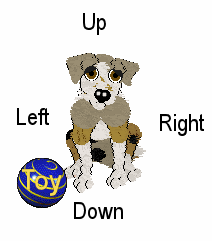
There are five types of tricks, Up, Down, Left, Right, and Toy. The above picture shows what side of the pet you need to wave the treat on to prompt a trick. For ‘Toy’ tricks, almost any toy can work (try waving a treat over the toy. If it whistles and the bottom says that you’ve signaled for a ‘Toy’ trick, then the toy works). The two circus balls work best, though, since they are designed for tricks.
In addition to five types of tricks, there are five types of treats:

The game registers the Beef Treats and the Bone Treats as the exact same treat. If you spend an hour teaching your pet five tricks for the Beef Treat, when you take out a Bone Treat, the pet will do the exact same five tricks. If you then teach the pet different tricks for the Bone Treat, it will become confused and not know what trick you want, doing both Beef Treat and Bone Treat tricks for both treats. The game also registers the Olive Treats and the Fish Treats as the same treat, and the Popcorn, Cotton Candy, and Luv Treats as the same treat. Furthermore, even though the game insists that petz will do tricks for the Healthy Treats too, I’ve found that the game won’t even let me call my petz to do tricks with them, so don’t waste your time trying anything with those.
In addition to the normal treats, there is one ‘secret’ treat—the cheese! The cheese used to lure mice from their holes actually does count as a treat. It’s much harder to train with, since it doesn’t have an unlimited supply in Petz 4 unless you’re in the Toy Closet, but on the flip side, I haven’t met a dog yet who will eat it (I’m sure they exist, I just don’t have one).
Those of you quick on the math might have already realized the limit of this: five types of treats, each treat can be tied to five types of tricks… that means every pet can ONLY learn 25 tricks. However, there are at least 36 tricks in the game. A pet cannot learn all 36, so you must pick your tricks wisely.
Here is a break down of all the tricks I have found, and what category of trick they are:
Back Kick: Pet jumps and kicks its legs out behind it.

Beg: Pet gets on hind legs and begs.
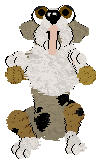
Circle Jump: Starting facing you, pet leaps into the air, turning a circle, always facing you.
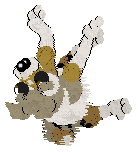
Hand Spring: Pet performs a handspring.
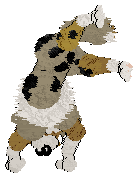
Handstand Walk: Pet performs a handstand and then begins to walk on its front legs only.
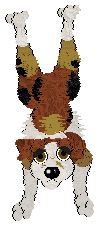
Headstand: Pet performs a headstand.
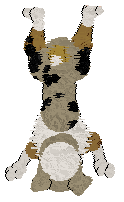
Heel Click: Pet leaps into the air and clicks its heels together.

High Jump: Pet leaps into the air as high as it can.
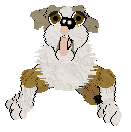
Loop Jump: Starting facing you, pet jumps into the air and turns a circle up and to the back.

One-Leg Stand: Pet rises up and balances on one leg.
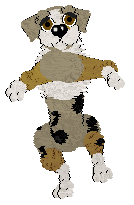
Screen Slide: Pet leaps onto the computer screen and slides down.
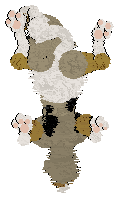
Walk Hind Legs: Pet gets up onto hind legs and walks.
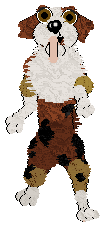
Lie Down Alert: Pet lies down with its head lifted.

Lie Down Rest: Pet lies down to rest and wait.
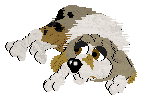
Play Dead: Pet rolls onto its back and freezes, usually with tongue out.
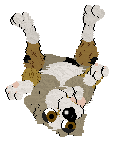
Roll onto Back: Pet rolls onto back and wiggles.

Sit: Pet sits. *NOTE: The pet may turn a sit trick into a wave trick. Wait a few seconds to make sure it isn’t about to wave before you reward for a sit trick*

Wave: Pet sits and then waves.
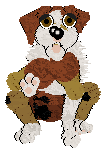
The left and right tricks are identical, just performed on either side. You can train a pet to have a different left trick for a treat than the right trick, or you can train the pet to have the same trick on both sides.
Leap: Pet turns to the side and then leaps.
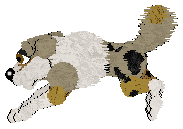
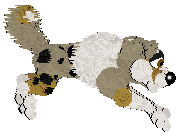
Side Hop: Pet moves sideways by jumping up and over in a little arc (different from Side Slide)
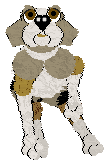

Side Roll: Pet lies down and rolls over, head always pointed in your direction.
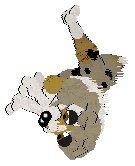
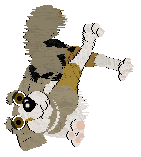
Side Slide: Pet moves sideways by moving first front feet and then back feet in a sliding motion (different from Side Hop).
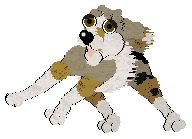
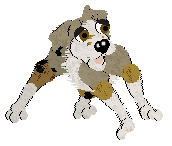
Somersault: Pet turns to the side and performs a somersault.
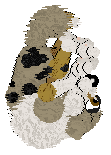

Wall Slide: Pet moves to a wall, leaps up on it, and slides back down.
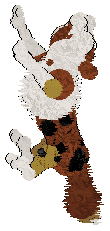
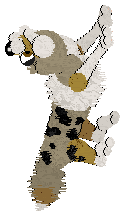
*JUMP TRICK* The pet always precludes this trick by giving a little jump in the air, but the ending is different – could hold itself to the side, could crouch and growl, could crouch to the side, could leap in a circle… Spider does not recommend teaching a pet this trick because it is impossible to train the ending (she tried for more than five hours on her most intelligent dog, only ever rewarding one ending, with no success)
There are only five toy tricks, and one shouldn’t count as a trick, so all petz can learn all of them. There are ‘beginner’ and ‘advanced’ tricks, and once a pet starts with ‘advanced,’ it’s harder to get it to do ‘beginner.’
Balance: -Beginner- Pet will jump onto a toy and balance.

Bounce: -Advanced- Pet will jump onto a toy and grip it with all four paws before beginning to bounce up and down.

Nose Balance: -Beginner- Pet will pick up a toy, toss it onto its nose, and balance it there.
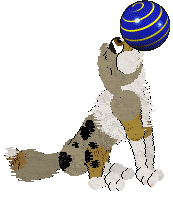


*Due to game problems, this trick will often look odd, as if the toy has sunk within the pet’s muzzle*
Nose Toss: -Advanced- Pet will pick up a toy, toss it onto its nose, and then toss it into the air, bouncing it off its nose.

*FETCH*: Pet picks up the toy and brings it to the hand. While a trick, it cannot really be captured in a picture.
A quick recap:
Remember, a pet can only learn 5 tricks from each category, so choose wisely.
Face Cover: The cat sits down and then reaches up, covering its eyes, repeating this gesture several times.

Speech: The cat stands up on its hind legs, one paw stretched up, one curled in front of it, as if giving a speech.

Circle Jump: The cat performs a circle jump like the dogz above, beginning by facing the owner, then jumping up and behind to create a circle that goes into the monitor.

Bounce: The cat bounces up and down excitedly.

Tail Chase: The cat chases its tail, first to the left, then to the right.

Crouch: The cat goes into a crouch, curling its tail behind it, several times.

Jump Splat: The cat leaps in the air and does not catch itself, ‘splatting’ on the ground.
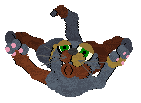
Somersault: The cat performs a somersault.


Leap: The cat jumps to the side *Different from Pounce*
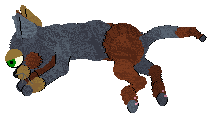

Pounce: The cat crouches down, curling its tail over it’s back, before springing to the side. *Different from Leap*
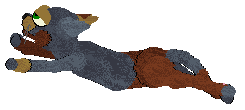

Fetch: The cat picks up the toy and brings it to the cursor.
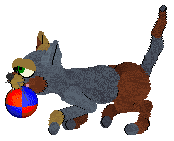
There are fewer cat tricks than dog tricks, so it is possible for a cat to learn every single trick.
Training methods vary from person to person, and everyone finds their own way which works best for them. Here, I’m going to detail my method, so beginning trainers can have some idea of what to do.
Before you begin, though, there’s one little fact that you need to know first. Tricks don’t transfer! If you train your pet in Petz 4, but want to play with it in Petz 5, it will not remember any of its tricks! Make sure you’re training your pet in the version you want it to know its tricks in.
To teach a pet a trick, you need two things:
A pet
A treat.
I always train my petz in an empty playscene, with no distractions, no ledges, no mice, no extra toys, no nothing. In the supply case, I keep one of every type of treat as well as a few toys – the pet’s favorite(s) and a circus ball. Sometimes, I include a spray bottle.
Take the pet out alone. Do not try to train two or more petz at once, because they will both register rewards, even if only one did the appropriate action. That’s if you’re lucky enough for them to pay attention to you instead of each other.
In Petz 4, you can keep the treat box in the supply case and take out one treat at a time. This is not the case in Petz 5, so find an off-to-the-side place to store your treats.
To begin with, I always have a list of what tricks I want my pet to learn – five of each category. I begin with the beef treat and wave it below the pet until it does a trick. If it is not a trick on my list, I DO NOT LET GO OF THE TREAT. This is the important part to training a pet – the moment you let go of the treat, the pet believes it did what it was supposed to and is more likely to do that next time. You might end up holding the same treat as the pet does fifty tricks, but as long as you don’t let it go, you aren’t enforcing the wrong behavior. If you grow tired of holding the treat and the pet still hasn’t done what you want, you can put the treat back in the treat box.
Once the pet does do one of the tricks on my list, I immediately drop the treat and let it have its reward. If you want to pet your pet as well (further rewards), wait until after it has eaten, or else it will forget the treat and then be distracted when you go to try again.
I continue to train the pet in the same trick until it does it five times in a row on the first try. If it does another trick before doing the correct trick, I reset my count. Once the pet has done the same trick five times in a row, I give it a lot of attention, petting it profusely (and praising it, even though I don’t have a microphone for voice recognition ¬__¬). If the pet has performed remarkably well, or has mastered a difficult trick, I’ll take out its toys and play with it, or bring out another pet to let it have some company. After a few minutes of playtime, though, toys and companions go away and it’s time to teach the pet another trick.
After a pet has mastered a trick, every time I open Petz, I bring it out and run through its tricks again, just to keep it fresh. If it has forgotten one, I retrain it to the 5 perfect repeats, but if it remembers, I’ll only have it do it two or three times.
Sometimes, the pet may be sneaky and rip the treat from your hand, munching on it even though it didn’t do the appropriate trick. When that happens, if I have it on hand, I grab the spray bottle and give it a squirt. The pet would have recognized a reward, even though it stole the treat. By spraying it, you lessen the effects. If you can’t spray it, though, don’t worry too much, just keep the treat away from the pet next time! Sometimes you can tell when the pet is about to spring for the treat, and you can move it out of reach.
With all these tricks that your pet now knows, you need a place to show them off, right? Right! I’ve come up with a new sports title (for dogz only, right now) and a competition standard that can be used to create dog shows for these tricks.
(RTD) Reserved Trickster Dog - 5 pts
(TD) Trickster Dog - 10 pts
(NTD) Novice Trickster Dog - 15 pts
(JTD) Junior Trickster Dog - 20 pts
(TPro) Trickster Pro - 30 pts
(TX) Trickster Excellent - 50 pts
(TMs) Trickster Masters - 100 pts
(RTL) Reserved Trickster Legend - 250 pts
Trickster Legend - 500 pts
A Trickster Show should consist of 4 tricks, drawn from the five categories above (Up, Down, Left, Right, and Toy) or Freestyle. Freestyle tricks do not have to be tricks like the ones found in this guide. A show pose could be considered a freestyle trick. Catching a frisbee, jumping through a hoop, using a petwalk, or even (for dogz), sitting on a high place rather calmly could all be considered freestyle tricks. Just make sure the person entering specifies what sort of freestyle trick their dog is doing.
You can now find the standards for dog tricks at my website! I have a page dedicated to the Trickster Shows! fantismalspider.googlepages.com/tricksters
Rachael @ Ingenuity has also done extensive work with training catz and been a great help in this guide. You can find her standards here: www.freewebs.com/ingenuity-/royalfools.htm
I’ll be working with my petz to come up with standard pictures for all of the tricks, pictures of what the tricks should look like. All of the pictures in the trick descriptions above show Tanya, Bow, or Buster demonstrating ‘perfect’ tricks. For the tricks, the pet should be aligned either directly facing the camera or side-on to the camera (for side tricks like somersaults or leaps). The pictures should be as balanced as possible. The exceptions to this are for toy tricks – those are very hard to align properly, so alignment shouldn’t be severely faulted. Game problems like how the balls don’t always balance where they should should also not be faulted. Treats are allowed to be visible in the pictures, but are preferred not to be.
**TIP** When you’re ready to start photographing your pet doing a trick, I’ve found it works best to change some game settings first. Turn AutoSave pictures on and put the game speed up to 100 (need PetzA for that). This slows down the game so you can get more pictures of your pet. When your pet begins doing the trick, move the treat out of the way as you hold down the spacebar. Then you can go back and look over your pictures to find the best one.
Good luck, and happy training!
This guide is unfinished, but I will not likely be making more research into this topic myself.
If you have any suggestions or additions, let me know!
Any time I make changes, I'll have the modifications in this green color so it'll stand out.
The Spider’s Guide to Trickster Petz
Petz 4 Edition[/center][/size]
It seems to me that there is a neglected aspect of the Petz games in the community, and that is the ability to teach your petz tricks. Oh, sure, sit, lie down, jump… these are all use for some types of shows, but what about the more fun tricks? How often do you see dogz turning handsprings or flipping through the air? There didn’t seem to be any resources on the web, though, relating to training petz to do tricks, so I thought I’d do my own research and write up a guide of my own.
Right now, this only really applies to petz in P4. I haven’t had time to experiment yet with P5 yet, but I will, and I will update this guide appropriate as I figure out those games.
This guide will be split into three sections, what tricks a pet can learn, how you can teach a pet tricks, and the Trickster competitions. Pictures will be included.
If you know of any tricks that I have missed, please let me know! All of these tricks were demonstrated by my dogz, Tanya and Bow, and my cat, Buster. It’s entirely possible that there are tricks they don’t know about or never showed off.
What Tricks Are There?
Petz can only learn a limited number of tricks, and if you try to replace an established trick with a new one, you can cause a lot of confusion and frustration in both your pet and yourself. It’s good, therefore, to know what tricks are out there for your pet to learn and how many your pet can learn before you begin training.

There are five types of tricks, Up, Down, Left, Right, and Toy. The above picture shows what side of the pet you need to wave the treat on to prompt a trick. For ‘Toy’ tricks, almost any toy can work (try waving a treat over the toy. If it whistles and the bottom says that you’ve signaled for a ‘Toy’ trick, then the toy works). The two circus balls work best, though, since they are designed for tricks.
In addition to five types of tricks, there are five types of treats:

The game registers the Beef Treats and the Bone Treats as the exact same treat. If you spend an hour teaching your pet five tricks for the Beef Treat, when you take out a Bone Treat, the pet will do the exact same five tricks. If you then teach the pet different tricks for the Bone Treat, it will become confused and not know what trick you want, doing both Beef Treat and Bone Treat tricks for both treats. The game also registers the Olive Treats and the Fish Treats as the same treat, and the Popcorn, Cotton Candy, and Luv Treats as the same treat. Furthermore, even though the game insists that petz will do tricks for the Healthy Treats too, I’ve found that the game won’t even let me call my petz to do tricks with them, so don’t waste your time trying anything with those.
In addition to the normal treats, there is one ‘secret’ treat—the cheese! The cheese used to lure mice from their holes actually does count as a treat. It’s much harder to train with, since it doesn’t have an unlimited supply in Petz 4 unless you’re in the Toy Closet, but on the flip side, I haven’t met a dog yet who will eat it (I’m sure they exist, I just don’t have one).
Those of you quick on the math might have already realized the limit of this: five types of treats, each treat can be tied to five types of tricks… that means every pet can ONLY learn 25 tricks. However, there are at least 36 tricks in the game. A pet cannot learn all 36, so you must pick your tricks wisely.
Here is a break down of all the tricks I have found, and what category of trick they are:
Dog Tricks
Up Tricks
Up Tricks
Back Kick: Pet jumps and kicks its legs out behind it.

Beg: Pet gets on hind legs and begs.

Circle Jump: Starting facing you, pet leaps into the air, turning a circle, always facing you.

Hand Spring: Pet performs a handspring.

Handstand Walk: Pet performs a handstand and then begins to walk on its front legs only.

Headstand: Pet performs a headstand.

Heel Click: Pet leaps into the air and clicks its heels together.

High Jump: Pet leaps into the air as high as it can.

Loop Jump: Starting facing you, pet jumps into the air and turns a circle up and to the back.

One-Leg Stand: Pet rises up and balances on one leg.

Screen Slide: Pet leaps onto the computer screen and slides down.

Walk Hind Legs: Pet gets up onto hind legs and walks.

Down Tricks
Lie Down Alert: Pet lies down with its head lifted.

Lie Down Rest: Pet lies down to rest and wait.

Play Dead: Pet rolls onto its back and freezes, usually with tongue out.

Roll onto Back: Pet rolls onto back and wiggles.

Sit: Pet sits. *NOTE: The pet may turn a sit trick into a wave trick. Wait a few seconds to make sure it isn’t about to wave before you reward for a sit trick*

Wave: Pet sits and then waves.

Left and Right Tricks
The left and right tricks are identical, just performed on either side. You can train a pet to have a different left trick for a treat than the right trick, or you can train the pet to have the same trick on both sides.
Leap: Pet turns to the side and then leaps.


Side Hop: Pet moves sideways by jumping up and over in a little arc (different from Side Slide)


Side Roll: Pet lies down and rolls over, head always pointed in your direction.


Side Slide: Pet moves sideways by moving first front feet and then back feet in a sliding motion (different from Side Hop).


Somersault: Pet turns to the side and performs a somersault.


Wall Slide: Pet moves to a wall, leaps up on it, and slides back down.


*JUMP TRICK* The pet always precludes this trick by giving a little jump in the air, but the ending is different – could hold itself to the side, could crouch and growl, could crouch to the side, could leap in a circle… Spider does not recommend teaching a pet this trick because it is impossible to train the ending (she tried for more than five hours on her most intelligent dog, only ever rewarding one ending, with no success)
Toy Tricks
There are only five toy tricks, and one shouldn’t count as a trick, so all petz can learn all of them. There are ‘beginner’ and ‘advanced’ tricks, and once a pet starts with ‘advanced,’ it’s harder to get it to do ‘beginner.’
Balance: -Beginner- Pet will jump onto a toy and balance.

Bounce: -Advanced- Pet will jump onto a toy and grip it with all four paws before beginning to bounce up and down.

Nose Balance: -Beginner- Pet will pick up a toy, toss it onto its nose, and balance it there.



*Due to game problems, this trick will often look odd, as if the toy has sunk within the pet’s muzzle*
Nose Toss: -Advanced- Pet will pick up a toy, toss it onto its nose, and then toss it into the air, bouncing it off its nose.

*FETCH*: Pet picks up the toy and brings it to the hand. While a trick, it cannot really be captured in a picture.
A quick recap:
| Up | Down | Left/Right | Toy |
| Back Kick | Lie Down Alert | Leap | Balance |
| Beg | Lie Down Rest | Side Hop | Bounce |
| Circle Jump | Play Dead | Side Roll | Nose Balance |
| Hand Spring | Roll onto Back | Side Slide | Nose Toss |
| Handstand Walk | Sit | Somersault | Fetch |
| Headstand | Wave | Wall Slide | |
| Heel Click | |||
| High Jump | |||
| Loop Jump | |||
| One-Leg Stand | |||
| Screen Slide | |||
| Walk Hind Legs |
Remember, a pet can only learn 5 tricks from each category, so choose wisely.
Catz Tricks
Up Tricks
Up Tricks
Face Cover: The cat sits down and then reaches up, covering its eyes, repeating this gesture several times.

Speech: The cat stands up on its hind legs, one paw stretched up, one curled in front of it, as if giving a speech.

Circle Jump: The cat performs a circle jump like the dogz above, beginning by facing the owner, then jumping up and behind to create a circle that goes into the monitor.

Bounce: The cat bounces up and down excitedly.

Down Tricks
Tail Chase: The cat chases its tail, first to the left, then to the right.

Crouch: The cat goes into a crouch, curling its tail behind it, several times.

Jump Splat: The cat leaps in the air and does not catch itself, ‘splatting’ on the ground.

Left/Right Tricks
Somersault: The cat performs a somersault.


Leap: The cat jumps to the side *Different from Pounce*


Pounce: The cat crouches down, curling its tail over it’s back, before springing to the side. *Different from Leap*


Toy Tricks
Fetch: The cat picks up the toy and brings it to the cursor.

There are fewer cat tricks than dog tricks, so it is possible for a cat to learn every single trick.
| Up | Down | Left/Right | Toy |
| Face Cover | Tail Chase | Somersault | Fetch |
| Speech | Crouch | Leap | |
| Circle Jump | Jump Splat | Pounce | |
| Bounce |
How to Train
Training methods vary from person to person, and everyone finds their own way which works best for them. Here, I’m going to detail my method, so beginning trainers can have some idea of what to do.
Before you begin, though, there’s one little fact that you need to know first. Tricks don’t transfer! If you train your pet in Petz 4, but want to play with it in Petz 5, it will not remember any of its tricks! Make sure you’re training your pet in the version you want it to know its tricks in.
To teach a pet a trick, you need two things:
A pet
A treat.
I always train my petz in an empty playscene, with no distractions, no ledges, no mice, no extra toys, no nothing. In the supply case, I keep one of every type of treat as well as a few toys – the pet’s favorite(s) and a circus ball. Sometimes, I include a spray bottle.
Take the pet out alone. Do not try to train two or more petz at once, because they will both register rewards, even if only one did the appropriate action. That’s if you’re lucky enough for them to pay attention to you instead of each other.
In Petz 4, you can keep the treat box in the supply case and take out one treat at a time. This is not the case in Petz 5, so find an off-to-the-side place to store your treats.
To begin with, I always have a list of what tricks I want my pet to learn – five of each category. I begin with the beef treat and wave it below the pet until it does a trick. If it is not a trick on my list, I DO NOT LET GO OF THE TREAT. This is the important part to training a pet – the moment you let go of the treat, the pet believes it did what it was supposed to and is more likely to do that next time. You might end up holding the same treat as the pet does fifty tricks, but as long as you don’t let it go, you aren’t enforcing the wrong behavior. If you grow tired of holding the treat and the pet still hasn’t done what you want, you can put the treat back in the treat box.
Once the pet does do one of the tricks on my list, I immediately drop the treat and let it have its reward. If you want to pet your pet as well (further rewards), wait until after it has eaten, or else it will forget the treat and then be distracted when you go to try again.
I continue to train the pet in the same trick until it does it five times in a row on the first try. If it does another trick before doing the correct trick, I reset my count. Once the pet has done the same trick five times in a row, I give it a lot of attention, petting it profusely (and praising it, even though I don’t have a microphone for voice recognition ¬__¬). If the pet has performed remarkably well, or has mastered a difficult trick, I’ll take out its toys and play with it, or bring out another pet to let it have some company. After a few minutes of playtime, though, toys and companions go away and it’s time to teach the pet another trick.
After a pet has mastered a trick, every time I open Petz, I bring it out and run through its tricks again, just to keep it fresh. If it has forgotten one, I retrain it to the 5 perfect repeats, but if it remembers, I’ll only have it do it two or three times.
Sometimes, the pet may be sneaky and rip the treat from your hand, munching on it even though it didn’t do the appropriate trick. When that happens, if I have it on hand, I grab the spray bottle and give it a squirt. The pet would have recognized a reward, even though it stole the treat. By spraying it, you lessen the effects. If you can’t spray it, though, don’t worry too much, just keep the treat away from the pet next time! Sometimes you can tell when the pet is about to spring for the treat, and you can move it out of reach.
The Trickster Competitions
With all these tricks that your pet now knows, you need a place to show them off, right? Right! I’ve come up with a new sports title (for dogz only, right now) and a competition standard that can be used to create dog shows for these tricks.
(RTD) Reserved Trickster Dog - 5 pts
(TD) Trickster Dog - 10 pts
(NTD) Novice Trickster Dog - 15 pts
(JTD) Junior Trickster Dog - 20 pts
(TPro) Trickster Pro - 30 pts
(TX) Trickster Excellent - 50 pts
(TMs) Trickster Masters - 100 pts
(RTL) Reserved Trickster Legend - 250 pts
Trickster Legend - 500 pts
A Trickster Show should consist of 4 tricks, drawn from the five categories above (Up, Down, Left, Right, and Toy) or Freestyle. Freestyle tricks do not have to be tricks like the ones found in this guide. A show pose could be considered a freestyle trick. Catching a frisbee, jumping through a hoop, using a petwalk, or even (for dogz), sitting on a high place rather calmly could all be considered freestyle tricks. Just make sure the person entering specifies what sort of freestyle trick their dog is doing.
You can now find the standards for dog tricks at my website! I have a page dedicated to the Trickster Shows! fantismalspider.googlepages.com/tricksters
Rachael @ Ingenuity has also done extensive work with training catz and been a great help in this guide. You can find her standards here: www.freewebs.com/ingenuity-/royalfools.htm
I’ll be working with my petz to come up with standard pictures for all of the tricks, pictures of what the tricks should look like. All of the pictures in the trick descriptions above show Tanya, Bow, or Buster demonstrating ‘perfect’ tricks. For the tricks, the pet should be aligned either directly facing the camera or side-on to the camera (for side tricks like somersaults or leaps). The pictures should be as balanced as possible. The exceptions to this are for toy tricks – those are very hard to align properly, so alignment shouldn’t be severely faulted. Game problems like how the balls don’t always balance where they should should also not be faulted. Treats are allowed to be visible in the pictures, but are preferred not to be.
**TIP** When you’re ready to start photographing your pet doing a trick, I’ve found it works best to change some game settings first. Turn AutoSave pictures on and put the game speed up to 100 (need PetzA for that). This slows down the game so you can get more pictures of your pet. When your pet begins doing the trick, move the treat out of the way as you hold down the spacebar. Then you can go back and look over your pictures to find the best one.
Good luck, and happy training!


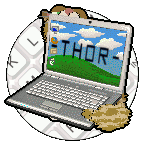



 I've been a slacker. *blush*
I've been a slacker. *blush*